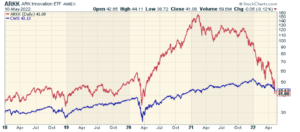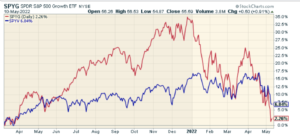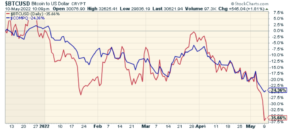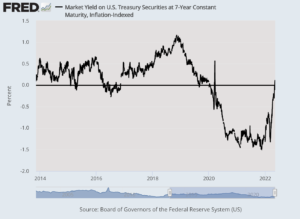CWS Market Review – May 10, 2022
(This is the free version of CWS Market Review. If you like what you see, then please sign up for the premium newsletter for $20 per month or $200 for the whole year. If you sign up today, you can see our two reports, “Your Handy Guide to Stock Orders” and “How Not to Get Screwed on Your Mortgage.”)
Yesterday, for the first time ever, the nominal price of the Advisor Shares Focused Equity ETF (CWS) closed above the nominal price of the Ark Innovation ETF (ARKK). The former is the ETF that’s based on our Buy List and the latter is the popular ETF run by Cathie Wood.

That’s a massive change of course in a short amount of time. Fifteen months ago, each share of ARKK was going for about four times each share of CWS. Now we’re slightly more.
I don’t point this out to gloat. I’m a fan and admirer of Wood’s. Rather, I do this to show the incredible dynamics underlying the current stock market.
Don’t Mistake Rotation for Brains
Wood’s style of investing is what’s called “factor riding.” She invested in nearly every high momentum stock and held on during a period when those stocks were very popular. Shares of ARKK exploded higher (the red line in the chart above).
That’s the easy part of factor riding. The problem is when the market turns against you. If your factor is out of style, the market can be merciless as it has been recently. Whenever you hear of easy and quick gains in the stock market, you can usually assume that the person is somehow engaged in factor riding.
Meanwhile, our style of investing is far more conservative and diversified. That’s why we lagged ARKK before and are leading it now.
So much of Wall Street is governed by which sectors are hot and which are not. Too often, investors mistake simple rotations for brains. Wall Street loves to jump from one shiny plaything to the next; “to everything there is a season.”
Yesterday was a terrible day for the stock market, and that came on top of a dismal market. In last week’s issue, I mentioned that the S&P 500 is off to its worst start for the year in 83 years. For the third time in seven sessions, the S&P 500 fell by more than 3%. On Monday, the S&P 500 closed below 4,000 for the first time since March 2021. We closed a hair above it today.
The S&P 500 peaked on January 3, the first trading day of the year. Official bear markets are typically defined as drawdowns of 20% or more. That means we’ve hit bear territory if the S&P 500 closes below 3,837.25. Today’s low was 3,969.07. Hold on, because we may test the bear level soon.
As bad as the S&P 500 has been, the Nasdaq has been doing even worse. The Nasdaq Composite fell 4.29% on Monday. By the closing bell, the index was down 27.61% from its November high close. The Nasdaq is already in a bear market.
Investors need to understand that the market’s rotation is largely related to the Fed’s interest-rate policy. As the Fed has raised rates in response to inflation, the riskier areas of the market have been severely punished. Meanwhile the more conservative sectors are down, but not nearly as much.
Here’s an update to a chart I ran last week of the S&P 500 Growth versus S&P 500 Value ETFs. You can see just how badly growth stocks have lagged.

Here’s another chart that I think shows a lot. This is the Nasdaq Composite compared with bitcoin.

The correlation isn’t super high, but there’s something there.
Why is this important? That’s because it shows how the market is treating all risky assets, even fairly disparate ones, as if they’re nearly the same. It’s as if the market is placing everything in one of two boxes. One is labeled “risky stuff” and the other is “everything else.”
Everything else is winning.
Last Wednesday, not long after I sent you last week’s issue, the Federal Reserve raised interest rates by 0.5%. There was no surprise there, and the market briefly rallied. On Friday, the market gave it another think and decided it wasn’t happy.
Markets don’t like higher rates. Even though rates aren’t that high yet, the impact is being felt. This is probably the first in a string of 0.5% rate increases. For a time, the market had been expecting a 0.75% increase at the June meeting. However, Fed Chairman Jerome Powell said that the Fed hasn’t been discussing a rate hike that large.
Nearly everything that happens in the stock market is a shadow of what’s going on with interest rates. That’s why the bond and currency markets are adjusting as well. The U.S. Dollar Index recently reached a 20-year high. As always, capital goes where it’s treated best. The yield on the 10-year Treasury recently closed above 3%. Both the 5- and 7-year have as well.
Here’s something interesting: The yield on the 7-year TIPs finally closed above 0%. These are Treasury Inflation-Protected securities which means the return is adjusted for inflation. Two months ago, the same yield was going for -1.33%. The message is that everyone is expecting higher rates. As long as there’s inflation, we’re going to see rates under pressure.

Speaking of which, the next inflation report comes out tomorrow, and it’s been inflation that’s finally woken the Fed up to the damage that it has done. I expect to see another report showing high inflation, although it’s possible that the core inflation number may come in light. The sad fact is that the Fed doesn’t have a good track record of fighting inflation without causing a recession. That’s why so many traders are on edge.
By the way, May panics aren’t unheard of on Wall Street. The Panic of 1837 lasted from May 8 to May 12. Back then, things got so out of hand that at one point, the New York militia had to be called to Wall Street. The effects of the panic didn’t subside for another seven years.
The Panic of 1893 started on May 1 and lasted until May 5. That year, over 600 banks went under. There wasn’t any relief until gold was discovered in the Klondike. In other words, the money supply increased.
While it wasn’t a traditional panic, 82 years ago today was probably the most important day of the 20th century. Germany invaded France, Chamberlain resigned, and Winston Churchill became prime minister. That day the Dow fell 3.4 points, or 2.3%. From May 9 to May 21, the Dow lost 23%.
During all those panics, the selling fervor eventually subsided; it just took time. The same will happen this time. One of my favorite market quotes is from Shelby Cullom Davis: “You make most of your money in a bear market; you just don’t realize it at the time.”
Trex Beats the Street
Investors tend to talk about their big winners and ignore their losers. Well today I want to talk about my biggest loser this year, and that’s Trex (TREX), the deck company.
Through Tuesday, Trex is down by more than half. If Trex magically jumped 50% tomorrow, it would still be our worst-performing stock this year.

Why am I talking about my disaster with this stock? That’s because I still like it. In fact, I think it’s going for a very good value right now.
It’s no mystery why Trex is down so much. It’s being lumped in with the housing market and the market is worried about higher mortgage rates wrecking Trex’s business.
For now, the evidence is that business is going very well. On Monday, Trex released a very good earnings report. (No, they weren’t beating lowered guidance. That’s a favorite trick on Wall Street.) The deck company reported Q1 earnings of 62 cents per share. That’s an increase of 48% over last year, and it was eight cents higher than expectations.
Quarterly sales rose 38% to $339 million. That was above the company’s own guidance of $320 to $330 million.
The CEO said:
“2022 is off to a strong start with Trex Residential posting 40% revenue growth, reflecting a double-digit increase in volume from strong secular trends, as homeowners continue to invest in existing residences and pursue renovations that enhance their outdoor living spaces. Price increases to address inflationary pressures were absorbed by the market and also benefitted net sales. As the category leader with newly expanded capacity, we believe that Trex is capturing more than its share of the ongoing conversion from wood to composite products,” said Bryan Fairbanks, President and CEO.
For Q2, Trex expects sales to range between $375 million to $385 million. At the midpoint, that’s an increase of 22%. For all of 2022, Trex expects double-digit revenue growth.
Trex rose more than 5% today. I can’t say that the rout in the stock is over, but the stock is down and business is going well. The market can’t ignore that forever. It’s not easy to stick with a stock that’s caused so much pain, but investing isn’t about emotions. I’m standing by Trex. By the way, if you want to know more about our Buy List stocks and what I think about them please sign up for our premium Substack. We just had a great earnings season.
That’s all for now. I’ll have more for you in the next issue of CWS Market Review.
– Eddy
P.S. You can get more info on our ETF here.
Posted by Eddy Elfenbein on May 10th, 2022 at 7:06 pm
The information in this blog post represents my own opinions and does not contain a recommendation for any particular security or investment. I or my affiliates may hold positions or other interests in securities mentioned in the Blog, please see my Disclaimer page for my full disclaimer.
-
-
Archives
- April 2025
- March 2025
- February 2025
- January 2025
- December 2024
- November 2024
- October 2024
- September 2024
- August 2024
- July 2024
- June 2024
- May 2024
- April 2024
- March 2024
- February 2024
- January 2024
- December 2023
- November 2023
- October 2023
- September 2023
- August 2023
- July 2023
- June 2023
- May 2023
- April 2023
- March 2023
- February 2023
- January 2023
- December 2022
- November 2022
- October 2022
- September 2022
- August 2022
- July 2022
- June 2022
- May 2022
- April 2022
- March 2022
- February 2022
- January 2022
- December 2021
- November 2021
- October 2021
- September 2021
- August 2021
- July 2021
- June 2021
- May 2021
- April 2021
- March 2021
- February 2021
- January 2021
- December 2020
- November 2020
- October 2020
- September 2020
- August 2020
- July 2020
- June 2020
- May 2020
- April 2020
- March 2020
- February 2020
- January 2020
- December 2019
- November 2019
- October 2019
- September 2019
- August 2019
- July 2019
- June 2019
- May 2019
- April 2019
- March 2019
- February 2019
- January 2019
- December 2018
- November 2018
- October 2018
- September 2018
- August 2018
- July 2018
- June 2018
- May 2018
- April 2018
- March 2018
- February 2018
- January 2018
- December 2017
- November 2017
- October 2017
- September 2017
- August 2017
- July 2017
- June 2017
- May 2017
- April 2017
- March 2017
- February 2017
- January 2017
- December 2016
- November 2016
- October 2016
- September 2016
- August 2016
- July 2016
- June 2016
- May 2016
- April 2016
- March 2016
- February 2016
- January 2016
- December 2015
- November 2015
- October 2015
- September 2015
- August 2015
- July 2015
- June 2015
- May 2015
- April 2015
- March 2015
- February 2015
- January 2015
- December 2014
- November 2014
- October 2014
- September 2014
- August 2014
- July 2014
- June 2014
- May 2014
- April 2014
- March 2014
- February 2014
- January 2014
- December 2013
- November 2013
- October 2013
- September 2013
- August 2013
- July 2013
- June 2013
- May 2013
- April 2013
- March 2013
- February 2013
- January 2013
- December 2012
- November 2012
- October 2012
- September 2012
- August 2012
- July 2012
- June 2012
- May 2012
- April 2012
- March 2012
- February 2012
- January 2012
- December 2011
- November 2011
- October 2011
- September 2011
- August 2011
- July 2011
- June 2011
- May 2011
- April 2011
- March 2011
- February 2011
- January 2011
- December 2010
- November 2010
- October 2010
- September 2010
- August 2010
- July 2010
- June 2010
- May 2010
- April 2010
- March 2010
- February 2010
- January 2010
- December 2009
- November 2009
- October 2009
- September 2009
- August 2009
- July 2009
- June 2009
- May 2009
- April 2009
- March 2009
- February 2009
- January 2009
- December 2008
- November 2008
- October 2008
- September 2008
- August 2008
- July 2008
- June 2008
- May 2008
- April 2008
- March 2008
- February 2008
- January 2008
- December 2007
- November 2007
- October 2007
- September 2007
- August 2007
- July 2007
- June 2007
- May 2007
- April 2007
- March 2007
- February 2007
- January 2007
- December 2006
- November 2006
- October 2006
- September 2006
- August 2006
- July 2006
- June 2006
- May 2006
- April 2006
- March 2006
- February 2006
- January 2006
- December 2005
- November 2005
- October 2005
- September 2005
- August 2005
- July 2005
 Eddy Elfenbein is a Washington, DC-based speaker, portfolio manager and editor of the blog Crossing Wall Street. His
Eddy Elfenbein is a Washington, DC-based speaker, portfolio manager and editor of the blog Crossing Wall Street. His